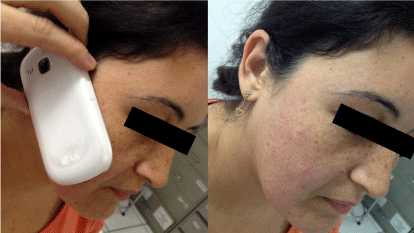
Case Report
Austin J Allergy. 2014;1(1): 1.
Facial Allergic Contact Dermatitis Caused by Mobile Phone
Rocha MA1
1Private Dermatology Office, São Paulo, Brazil
*Corresponding author: Marco Alexandre Dias Da Rocha, Private Dermatology Office, São Paulo, Brazil.
Received: June 27, 2014; Accepted:Aug 04, 2014; Published: Aug 06, 2014
Keywords
Allergic contact dermatitis; Mobile phone; Non-occupational
Case Report
A 35-year-ond woman was referred with pruritic dermatitis only in the right side of jaw line (Figure 1). The eruption began 2 weeks after buying a new cell phone. Patient had no atopic history and did not report other past allergies. No changes were found in the blood count.
Figure 1: Mobile phone dermatitis in the right jaw line.
Patch testing was performed with the Brazilian base line series. Finn Chambers (8mm) were used. The patch tests were applied to the upper back and occluded for 2 days. Readings were performed on day 3 and day 5. Positive test reactions were observed to thiuram mix, thimerosal, nickel sulfate, p-phenylenediamine and neomycin with p-phenylenediamine. The nickel sulfate test was considered strong positive. The cobalt test was negative. Nickel sulfate were found in the product. The patients was treated with a 10 days course, two times a day, of medium potency topical corticosteroid, and changed immediately her cell phone, with resulted in rapid clearance of the dermatitis, without return.
Discussion
This case report illustrates that technology gadgets can produce allergic contact dermatitis. The allergy results from frequent skin contact with nickel-containing objects [1]. Prolonged or repetitive contact with a nickel-containing phone is more likely to cause a skin reaction in those who are allergic to nickel. Nearly half of the phones we spot tested contained some free nickel. The menu buttons, decorative logos on the headsets and the metallic frames around the liquid crystal display (LCD) screens were the most common sites [2- 5]. In this case the central button is metallic and was the source of nickel (Figure 2). Nickel allergy affects up to 17% of women and 3% of men, and is the most common cause of contact sensitization, both in the general population and in dermatitis patients [6,7].
Figure 2: Mobile phone with nickel-containing objects.
References
- Rajpara A1, Feldman SR. Cell phone allergic contact dermatitis: Case report and review. Dermatol Online J 16: 9.
- Pazzaglia M, Pasquale L, Colombina V, Tosti A. Contact dermatitis from nickel in mobile phone. Contact Dermatitis. 2000; 42: 362–363.
- Bercovitch L, Luo J. Cellphone Contact Dermatitis with Nickel Allergy. CMAJ 2008; 178: 23-24.
- Livideanu C, Giordano-Labadie F, Paul C. Cellular phone addiction and allergic contact dermatitis to nickel. Contact Dermatitis 2007; 57: 130–131.
- Seishima M, Oyama Z, Yamamura M. Cellular phone dermatitis. Arch Dermatol 2002; 138: 272–273.
- Thyssen J P, Linneberg A, Menn’eT, Johansen J D. The epidemiology of contact allergy in the general population – prevalence andmain findings. Contact Dermatitis. 2007; 57: 287–299.
- UterW, Ramsch C, AbererW, Ayala F, Balato A, et al. The European baseline series in 10 European Countries, 2005/2006 – results of the European Surveillance System on Contact Allergies (ESSCA). Contact Dermatitis. 2009; 61: 31–38.

